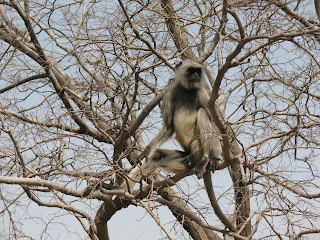
The irony is that some well-meaning Christians sent fine Belgium glass balls to India so the locals could decorate their Christmas trees. The locals were not Christians and there are no Christmas trees for thousands of miles. The Jain broke the balls and used them to embellish their temple with stunning results. You can see the balls in vertical rows just above the lower arches. There is additional tile and glass imported from Europe all over the temple and the Jain also covered their door with a thick layer of solid silver. Not exactly the impoverished Indians that needed the European charity.

The road to Jodpur, like most of the roads we traveled, was good and there was little traffic away from the towns. The women appeared to do most of the maintenance work although it was the men who worked with the equipment.

I had heard of Jodhpur when I was a child as this was where the British discovered the tight riding pants known as jodpurs that I used to have to wear when I rode my horse in England. I actually saw some people wearing them but the overwhelming attraction in this part of India was the Mehrangarh Fort.

Mehrangarh Fort in Jodhpur is another of the forts of Rajastan that appear to be completely impenetrable. It rises imposingly out of the desert, sitting on top of an acropolis with walls rising over a hundred feet higher.

The road to Jodpur, like most of the roads we traveled, was good and there was little traffic away from the towns. The women appeared to do most of the maintenance work although it was the men who worked with the equipment.

I had heard of Jodhpur when I was a child as this was where the British discovered the tight riding pants known as jodpurs that I used to have to wear when I rode my horse in England. I actually saw some people wearing them but the overwhelming attraction in this part of India was the Mehrangarh Fort.

Mehrangarh Fort in Jodhpur is another of the forts of Rajastan that appear to be completely impenetrable. It rises imposingly out of the desert, sitting on top of an acropolis with walls rising over a hundred feet higher.
The fort was taken. These are the hand prints of the wives and concubines of various maharajahs who threw themselves on his funeral pyre rather than become prisoners. I find it hard to conceive of such an act.


The entrance to the fort is a winding path to prevent a high speed elephant charge. This picture was taken looking up from the entrance way to the houses inside the fort.


The houses inside the fort are magnificent examples of finely carved sandstone and marble.

Jodhpur is known as the Blue City and it is clear to see why. Many locals paint their homes blue. The chemical copper sulphate in the whitewash turns it blue and deters termites. They believe it keeps the houses cooler as well. It does give a distinctive cool charm to the city.


It didn’t matter whether it was bags of rice or children’s dresses there was always vibrant color.
Piles of various rices and beans were available with a selection of spices to tickle your nose.

Beyond the actual market, shops extended into the narrow streets of Jodhpur offering everything you can imagine.

Jodhpur is known as the Blue City and it is clear to see why. Many locals paint their homes blue. The chemical copper sulphate in the whitewash turns it blue and deters termites. They believe it keeps the houses cooler as well. It does give a distinctive cool charm to the city.

We then went down to the market in the center of town. The approach was through
an elaborate tower with arches.

It didn’t matter whether it was bags of rice or children’s dresses there was always vibrant color.

Piles of various rices and beans were available with a selection of spices to tickle your nose.

Beyond the actual market, shops extended into the narrow streets of Jodhpur offering everything you can imagine.










































